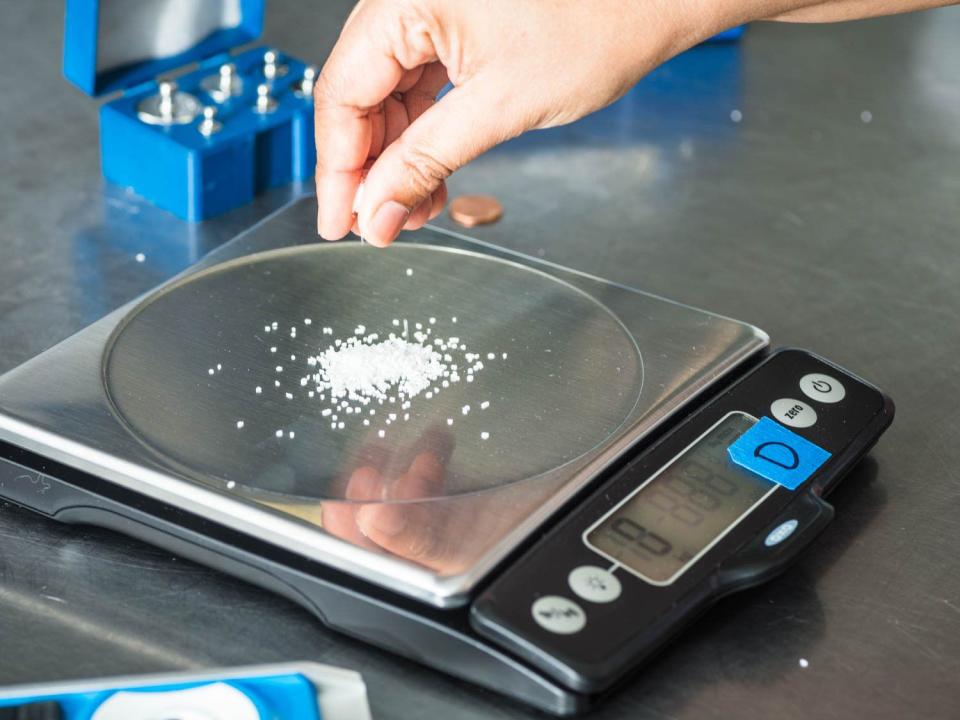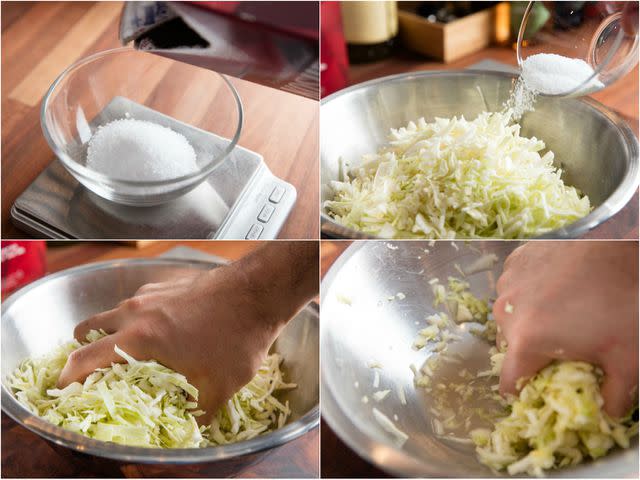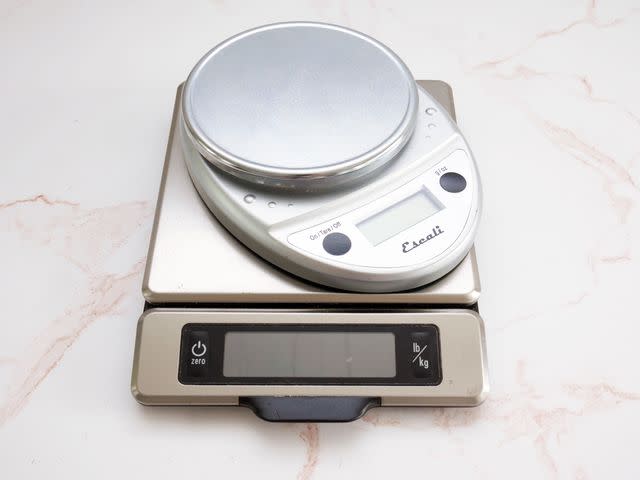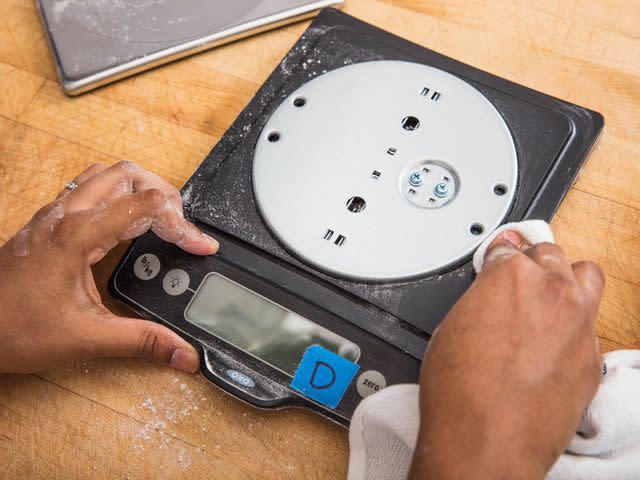How a Kitchen Scale Can Make You a Better Baker (and Cook)
Dotdash Meredith and Yahoo Inc. may earn commission or revenue on some items through the links below.
Precise measurements? Check. Recipe conversion? Easy. Less dirty dishes? Probably!

Serious Eats / Emily Dryden
While professional bakers have long sung the praises of baking by weight, some home bakers may still be wary of adopting kitchen scales as their primary measuring tool. And we get it—if you’re used to baking by volume using cups, teaspoons, and tablespoons, switching to a scale can seem unnecessary. However, if you’re not using a kitchen scale yet, you’re missing out on a tool that will make your baked goods better, your pickles crunchier (it's essential for figuring out the ratio of ingredients to brine), and your dishwasher emptier.
As a long-time professional baker, I consider my kitchen scale to be one of my most important kitchen tools, and you should too. As part of my quest to convert many a kitchen-scale nonbeliever, I also reached out to David Johnson, kitchen manager at the Rhode Island School of Design (and former executive chef at Bayberry Beer Hall) and Benjamin Stroud, prep cook at the eddy bar in Providence, Rhode Island, to get their input on how they think scales benefit their kitchen endeavors.
The Best Kitchen Scale: OXO Good Grips Stainless Steel Food Scale

The Best Budget Kitchen Scale: Escali Primo Digital Food Scale

Scales are Great for Baking—and Beyond
Another complaint I often hear is that baking is soooo precise that there’s no room for error. It’s true that baking requires more precision, so it makes sense to use a precision tool to do a precise task. Rather than counting out multiple cups of flour or adding 1/4 to 1/2 to 1 teaspoon because your recipe calls for 1 3/4 teaspoons of something, you can just use a scale. I remember as a kid using something like 16 quarter cups of flour to make my dad’s birthday cake because the quarter cup measure was the only one that fit in the flour jar. I also remember losing count, and starting over, moving the flour from one bowl to another (oh look—another dirty dish!).
Other precise kitchen tasks can benefit from using a scale, like fermenting vegetables, for example. If you’re the type to lacto-ferment pickles or make your own sauerkraut, a scale ensures finding the proper ratio of vegetables and liquid to salt.

And if you like making jam, a scale is necessary for weighing it to determine how much sugar to add. I usually like to make a quick and tasty “fridge jam” (not shelf-stable) by adding about 60% of the weight of the fruit in sugar before cooking it to 220°F. Chef Stroud says, “If I’m making something I know I’m going to want to recreate, I definitely pull out a scale and a pad of paper. If you know you have, say, 20 grams of salt in something and it tastes just a little too salty, it’s very easy to look at it and say, ‘Let’s drop it to 17 grams and go from there.’ Teaspoons and tablespoons are inconsistent and there isn’t a lot of gradation between them.”
Read More: The Best and Most Accurate Way to Measure Wet and Dry Ingredients for Baking
Using a Scale Makes Recipe Conversion Easy
Another advantage of using a scale is that you never have to switch between units (cups, teaspoons, tablespoons) which means you don’t need to learn any conversions, and you can always bake exactly as much product as you want. Did you know there are three teaspoons in a tablespoon, and 16 tablespoons in a cup? You will need to know (or look up) all of these equivalencies and more if you want to accurately halve or double a recipe written in volume. But if your recipe is in grams, you can easily adjust it in a few minutes with some basic math.
Using a Kitchen Scale = Less Dirty Dishes
One of the biggest complaints I hear about cooking and baking at home is the number of dirty dishes —but there’s good news: a scale can help you cut down on this. Instead of getting out your liquid measuring cups, dry measuring cups, measuring spoons, and so on, you can weigh everything right into your mixing bowl. I find this especially helpful for ingredients like honey and peanut butter, which often cling to measuring spoons and cups. You can also prevent cross-contamination in your ingredient containers; no dipping the same measuring cup in the flour, then the nuts, then the sugar…
How to Choose a Kitchen Scale

Serious Eats / Grace Kelly
Our favorite scales, from OXO and Escali, offer incredible accuracy across a range of weights, but make sure you choose the right scale for the job (e.g. if you’re measuring a small amount of yeast, scales might struggle to register it). A good rule of thumb is to refrain from using your scale to measure any amount smaller than 10 times its smallest measurement. For example, if your scale measures in grams, you wouldn’t want to use it for any amount smaller than 10 grams. When you’re measuring powerful ingredients such as yeast, salt, and baking powder or soda, each gram matters —rounding errors can swing your measurements too far off to be useful.
I keep a set of measuring spoons on hand for my smallest measurements, but you could also use a jeweler’s scale if you have one; these are accurate down to the 0.1 gram (but I wouldn’t use one to measure anything smaller than 1 gram). The flip side of a little scale is that they usually have a small platform and a low maximum weight. If you’re only going to invest in one scale (like one of our winners, which were accurate and versatile), look for accuracy down to a gram and keep using measuring spoons for small quantities of ingredients.
Tips for Scale Cleaning and Care

Serious Eats / Emily Dryden
For basic clean-up, you can clean your scale just like you clean your counters. A quick wipe-down with a damp soapy sponge followed by a spray of food-safe sanitizer should be enough to recover from most projects. Most kitchen scales are relatively water-resistant, but avoid soaking your scale in liquid. Chef Johnson notes that his beloved Escali scale took a swim in the dish sink, but was restored to life after a 48-hour drying period with the batteries out.
If you start to notice a buildup of debris in the cracks and seams around buttons, spray your scale with a little cleaning product, and use a toothpick or cotton swab to remove sediment from the details. Some scales (like our favorite from OXO)
feature removable platforms that you can hand-wash separately in the sink. This is a great feature for when you’re weighing food out directly onto your scale’s surface like portioning bread dough into evenly-sized rolls.
FAQs
Should I measure in grams or ounces and pounds?
Some of the benefits of using a scale are lost when you measure in ounces instead of grams. All of those simple numbers and easy math? Gone when you're dealing with a quantity like one lb, 14.5 ounces. If I’m making a recipe for the first time, and it happens to be in ounces, I will happily switch the units on my scale and carry on as the author intended. If the recipe is a keeper, I will quickly convert it to grams using an online calculator. I keep a notebook in the kitchen for this purpose.
How do I convert a recipe from volume to weight?
There are lots of resources online to convert recipes. I use this one, but it does require you to whip out a calculator and multiply the given unit by the amount in your recipe. Online calculators make this job even easier. Googling the phrase “how many grams of honey is in 3 tablespoons” led me to several accurate answers (63 grams). I like to write out the entire ingredient list in the same order as the recipe author (with my new gram measurements, of course) so I don’t get lost along the way.
Do you really need to bake with a scale?
Many bakers continue to use volumetric measurements for their baking with great success. The key to doing so is to be incredibly consistent with your procedures. You should ideally sift your flour before measuring it, and gently spoon it into your measuring cup. Overfill it a bit before using a smooth flat object like an offset spatula to level it off. You will need to repeat that process for all of your dry ingredients while keeping an accurate count of what you’ve added. You also want to make sure that your measuring implements are accurate; there is a surprising amount of variation across different brands and designs. The reason for all of this fuss is that many ingredients can expand or compress. Once you spoon your flour into the measuring cup, for instance, you could tap it on the counter, use your spoon to push it into the corners, and probably fit a few more tablespoons of flour into the cup. It would still be “a cup of flour” but it would certainly not be the same amount as you put in originally. When faced with this level of uncertainty, I know that I choose to switch to a scale (and I even convert recipes originally written in volume to grams before I start baking).
How can I tell if my scale is accurate?
An easy way to test the accuracy of your kitchen scale is to weigh the same item multiple times. It should register the same weight no matter the placement on the scale or amount of weight already on the scale. Zero your scale with something like a bowl on it. Scoot the bowl around the platform, take it off, put it back on. Your scale should stay at “0” at all times that the bowl is on the scale (as long as the bowl isn’t resting against any other nearby items). If it fluctuates by even a few grams, see if you can tighten up any connections, and if not, it may be time to replace your scale. If you want to test the calibration, you will need something with a known weight. There are scale calibration weights you can purchase, or you can use a few new nickels. They weigh five grams each, so stack up a few and test your scale’s accuracy and calibration.
Read More: We Tested 13 Kitchen Scales to Find the Best Ones

